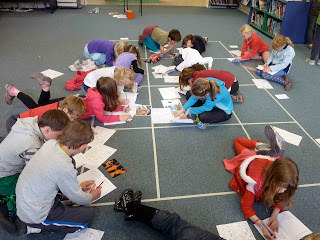 |
Agora at the end of the 5th century BC
Today we spent the day as Athenians of the golden age in the agora (marketplace). We began by doing some inquiry research about the
agora. In pairs we read some fact
sheets, compared maps of the Athenian agora in the 5th and 4th
centuries BC, and looked at some artists’ illustrations of what the agora might
have looked like in the golden age.
|
We answered the following questions:
1. what sorts of things might you buy and sell in the agora?
2. what kinds of people might spend time in the agora?
3. what activities might go on in the agora?
We also created two sentences of conversation that might be
overheard in the agora.
We then gathered all our ideas together onto large sheets of
newsprint, synthesising our information.
We had to note what each other had discovered and recorded to make sure
we didn’t double up on information.
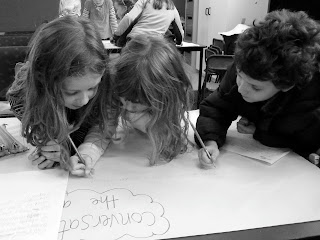 |
| Organising ideas. |
We then used these sheets of newsprint to plan how we could
transform the classroom into an ancient Athenian agora. I had no pre-plan of how this part was going to go, it was to be the children's creation - I would be there to guide and help if needed. Abigail suggested we start with a plan
of where everything would go in the classroom so labels were made for the
different types of stalls and areas in the agora and these labels were placed
around the classroom. Once we had
a rough layout for our agora everyone chose what kinds of people they were
going to be. Everyone then went
off to the different areas to create their stalls/areas. The classroom quickly became a buzz of
imagination and creativity. We
had:
-slave traders and slaves
-a blacksmith making weapons
-food stalls selling bread, meat, fruit, and vegetables
-a flower stall
-a pizzeria stall owner
-a pottery stall selling amphoras
-a clothes and shoemaker stall selling chitons and sandals
-a water fountain
-the Pnyx area for speeches
-a sign for the Port of Piraeus and a trireme in the port
-the Athenian mint where silver was being made into coins.
Stalls were filled with produce, conversations written,
speeches to be delivered at the Pnyx were written, statues put up, a trireme in
port drawn, and a water fountain was created.
Amphoras,
coins, and
weapons were drawn in amazing detail
using images we had come across in our work as
archaeologists, items of clothes
were correctly labelled as
chitons (tunics),
sandals and
himations (cloaks),
likely pizza toppings had to be looked up (Hawaiian probably unlikely!).
Someone asked about the kinds of money that would have been used and so we did
some research and learnt about
tetradrachms (equivalent to a handful of silver)
and
obols (a sixth of a tetradrachm).
 |
| Athenian coins with the symbol of the owl. |
 |
| Finlay's trireme in the Port of Piraeus. |
A lot of new inquiry work arose out of our play today and it
was fun being able to apply so much of our new knowledge from the last few
weeks – we have all learned a lot!
Conversations between housewives picked up on the limited
rights of
women in ancient Athens. There
were speeches delivered at the
Pnyx about how to spend the new found
silver at
Laurion drawing on new learning about
triremes/war strategy, and
Pericles’ ideas
for the
beautification of Athens.
There was even a speech written about the system of ostracisizing
citizens with
ostracons and another about increasing the rights of slaves. A
water clock was made to time the
speeches too (Leon was our water clock and he poured water from one container
to the other to time each speech!).
READY! THE
AGORA IS OPEN – LET THE TRADING BEGIN!
First we used the convention of a Circular Drama where we
watched parts of our market come alive.
We listened to some speeches in the Pnyx, watched a slave trade, and
overheard some conversations between a couple of housewives collecting water
from the fountain.
 |
| Two housewives collecting water at the fountain - carrying amphoras on their head that they purchased from the pottery vendor. |
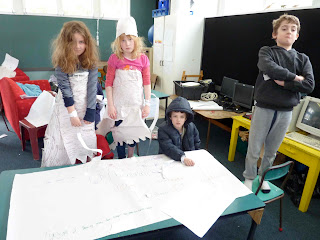 |
| Slave Market. |
 |
| Pericles speaking at the Pnyx (Leon is the water clock!) |
“Hello citizens of Athens, my name is Pericles and I love to speak to you! I think we should have a lot less violence to make our city very beautiful. We should make statues and new buildings for our beautiful city because a beautiful city equals a popular city. (clapping for audience) Thank you! Thank you!"
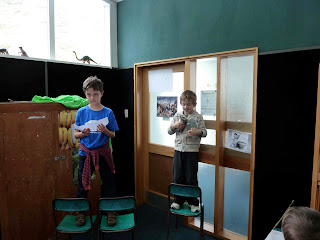 |
| Themistocles speaking at the Pnyx (Leon is the water clock!) |
“
Hello, my name is Themistocles and I speak for you people. I think we should spend money on good things. Things to protect us from war. Now that we have found silver from the mines at Laurion I think we should build 200 more triremes for protection in wars (clapping from audience) Thank you! Thank you!”
 |
| Ancient Athenian Ostrakon. |
“We should get rid of Leonardo because he robbed us! Please vote now! He deserves to be sent away! We need to ostrasize him. We need to write his name on 6,000 pieces of pottery to send him away for ten years. (clapping from audience). Thank you! Thank you!” (Another speech at the Pnyx).
Then we played in our market, all getting into role and visiting each others stalls to buy and sell things. There were handbags of tetradrachms and obols which were used to purchase food, flowers, weapons, clothes, pottery, and pizzas! Lots of fun!
 |
| Ready to shop! |
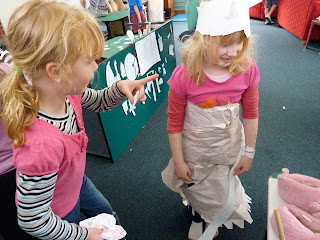 |
| A housewife with her new slave. |
 |
Blacksmith - Weapon Shop
|
 |
| Flower Stall |
 |
| Pottery Stall |
 |
| Food Shopping |
 |
| Taking pizza orders |
 |
| Shopping |














